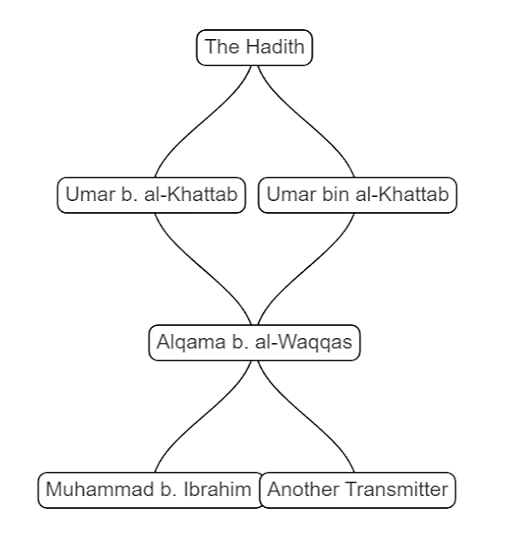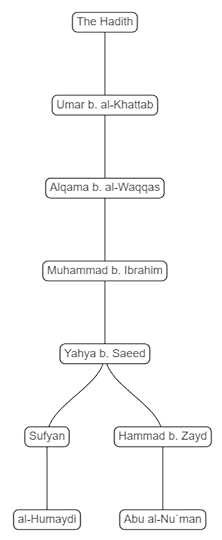On Using HadithGraph
Link to the tool: HadithGraph
I have been quietly working on a tool that automatically “verifies” hadiths (based on my hadith verification method) and draws diagrams of the hadith’s chains, and recently I finished it, and the results far exceeded my expectations, alhamdulillah. The tool is simply a calculator and diagrammer, so that instead of having to do the probability calculations and diagramming manually, they all take place automatically.
Users can use the tool merely for diagramming hadith chains, even if they have no interest in the probability calculations.
Rewriting and inputting the chainsGiven the Bukhari hadith (Bukhari #1):
حَدَّثَنَا الحُمَيْدِيُّ عَبْدُ اللَّهِ بْنُ الزُّبَيْرِ ، قَالَ : حَدَّثَنَا سُفْيَانُ ، قَالَ : حَدَّثَنَا يَحْيَى بْنُ سَعِيدٍ الأَنْصَارِيُّ ، قَالَ : أَخْبَرَنِي مُحَمَّدُ بْنُ إِبْرَاهِيمَ التَّيْمِيُّ ، أَنَّهُ سَمِعَ عَلْقَمَةَ بْنَ وَقَّاصٍ اللَّيْثِيَّ ، يَقُولُ : سَمِعْتُ عُمَرَ بْنَ الخَطَّابِ رَضِيَ اللَّهُ عَنْهُ عَلَى المِنْبَرِ قَالَ : سَمِعْتُ رَسُولَ اللَّهِ صَلَّى اللَّهُ عَلَيْهِ وَسَلَّمَ يَقُولُ : إِنَّمَا الأَعْمَالُ بِالنِّيَّاتِ ، وَإِنَّمَا لِكُلِّ امْرِئٍ مَا نَوَى ، فَمَنْ كَانَتْ هِجْرَتُهُ إِلَى دُنْيَا يُصِيبُهَا ، أَوْ إِلَى امْرَأَةٍ يَنْكِحُهَا ، فَهِجْرَتُهُ إِلَى مَا هَاجَرَ إِلَيْهِ *
Enter the hadith’s isnad in the textbox as follows:
Umar b. al-Khattab > Alqama b. al-Waqqas > Muhammad b. Ibrahim > Yahya b. Saeed > Sufyan > al-Humaydi
The chain starts from the chief transmitter (the Companion, in this case Umar. b. al-Khattab [RA]), and the transmitter names are separated by ” > “. Note that there are spaces before and after the “>”.
The spelling of the names does not matter as long as it is consistent. You must always use the same exact spelling for each unique transmitter, so Umar b. al-Khattab must always be spelled “Umar b. al-Khattab” in any additional chains you add.
But there is no need to worry too much about getting spellings wrong, because the diagram will immediately make it obvious by making the transmitter show up twice (below we have erroneously spelled Umar b. al-Khattab’s name differently on different chains):

Then gather additional chains for this hadith using hadith search engines and/or takhrīj tools, for example Bukhari #6587 gives us another chain for the hadith:
6587 حَدَّثَنَا أَبُو النُّعْمَانِ ، حَدَّثَنَا حَمَّادُ بْنُ زَيْدٍ ، عَنْ يَحْيَى بْنِ سَعِيدٍ ، عَنْ مُحَمَّدِ بْنِ إِبْرَاهِيمَ ، عَنْ عَلْقَمَةَ بْنِ وَقَّاصٍ ، قَالَ : سَمِعْتُ عُمَرَ بْنَ الخَطَّابِ رَضِيَ اللَّهُ عَنْهُ ، يَخْطُبُ قَالَ : سَمِعْتُ النَّبِيَّ صَلَّى اللَّهُ عَلَيْهِ وَسَلَّمَ يَقُولُ : يَا أَيُّهَا النَّاسُ ، إِنَّمَا الأَعْمَالُ بِالنِّيَّةِ ، وَإِنَّمَا لِامْرِئٍ مَا نَوَى ، فَمَنْ كَانَتْ هِجْرَتُهُ إِلَى اللَّهِ وَرَسُولِهِ ، فَهِجْرَتُهُ إِلَى اللَّهِ وَرَسُولِهِ ، وَمَنْ هَاجَرَ إِلَى دُنْيَا يُصِيبُهَا أَوِ امْرَأَةٍ يَتَزَوَّجُهَا ، فَهِجْرَتُهُ إِلَى مَا هَاجَرَ إِلَيْهِ *
Now enter the new chain from this second hadith into a new line in the textbox, so that we have the following two lines:
Umar b. al-Khattab > Alqama b. al-Waqqas > Muhammad b. Ibrahim > Yahya b. Saeed > Sufyan > al-Humaydi
Umar b. al-Khattab > Alqama b. al-Waqqas > Muhammad b. Ibrahim > Yahya b. Saeed > Hammad b. Zayd > Abu al-Nu`man
Now we get the following diagram:

And below we have added a chain from a third hadith (Bukhari 3719):
Adding commentsUmar b. al-Khattab > Alqama b. al-Waqqas > Muhammad b. Ibrahim > Yahya b. Saeed > Sufyan > al-Humaydi
Umar b. al-Khattab > Alqama b. al-Waqqas > Muhammad b. Ibrahim > Yahya b. Saeed > Hammad b. Zayd > Abu al-Nu`man
Umar b. al-Khattab > Alqama b. al-Waqqas > Muhammad b. Ibrahim > Yahya b. Saeed > Hammad b. Zayd > Musaddad
Comments can be added for your own convenience; they have no effect on the diagram or probability calculation. Comments start with a “#” character. You can add comments before each chain as follows:
Setting custom probabilities# Bukhari 1
Umar b. al-Khattab > Alqama b. al-Waqqas > Muhammad b. Ibrahim > Yahya b. Saeed > Sufyan > al-Humaydi
# Bukhari 6587
Umar b. al-Khattab > Alqama b. al-Waqqas > Muhammad b. Ibrahim > Yahya b. Saeed > Hammad b. Zayd > Abu al-Nu`man
# Bukhari 3719
Umar b. al-Khattab > Alqama b. al-Waqqas > Muhammad b. Ibrahim > Yahya b. Saeed > Hammad b. Zayd > Musaddad
Each transmitter has a default probability 0.6 (i.e. 60%). Sometimes you are dealing with transmitters who are lower quality, although not totally unreliable. In those cases you can set a custom probability in brackets after the transmitter’s name, as follows:
Transmitter 1 > Transmitter 2 (0.4) > Transmitter 3
Above, Transmitter 2 gets a probability of 0.4 (40%) in the calculations.
Setting probabilities above 0.6 will be ignored.
We are verifying meaningsThis tool gives the probable authenticity of the text (matn) of the hadith. But some variant hadiths sometimes contain additional sentences or lack them. Make sure all of the chains are the chains of hadith texts that mention the meaning you are trying to verify, such as “all actions are judged (by God) by the intentions behind them”.



